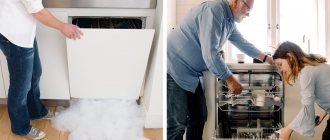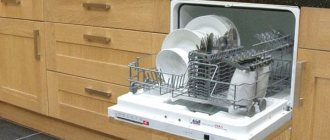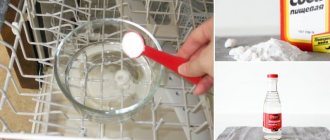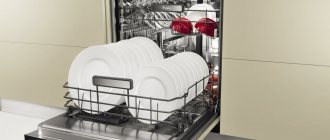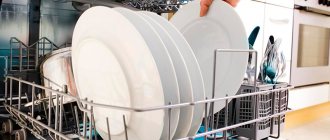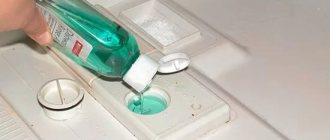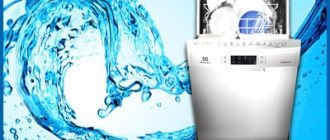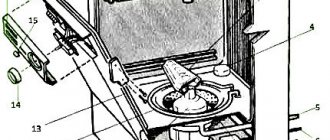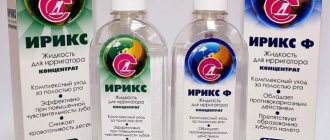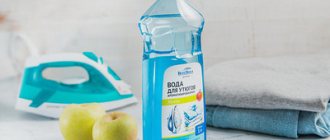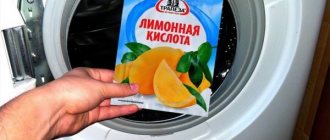Why do you need rinse aid for your dishwasher?
Its main function is to complement the work of the detergent. During the washing process, cutlery is exposed to detergents dissolved in water. Then the dirt is removed, but drops and streaks with chemical residues still remain on the surface. And only at the last stage do kitchen utensils become shiny and perfectly clean, and stains disappear.
Modern machine rinses are quite aggressive, as they must cope with any contamination. They are more concentrated, because there is no direct contact with the skin, which means they can effectively and quickly remove fat and thick plaque. But it is impossible to remove them without additional funds. Conventional household chemicals create abundant foam, which is not suitable for PMM.
The rinse aid performs three main functions:
Why do you need a rinse aid?
Some users refuse to use dishwasher rinse aid. In fact, the composition is used sparingly, so you should not neglect it. What function does this tool perform?
- Due to cationic and ionic substances, rinse aid helps the main detergent remove stubborn dirt from dishes.
- Non-ionic particles prevent excessive foaming.
- The alcohol components included in the composition prevent a film from forming on cutlery.
- Acids neutralize aggressive components found in detergents.
- Polycarboxylates protect the dishwasher from scale and corrosion.
The main active ingredients are combined with water. Some rinses contain fragrances and natural oils. They give cutlery a light, unobtrusive aroma.
If you are using a multifunctional dishwasher detergent, you do not need to pour rinse aid into the machine. Such capsules, tablets and powders already contain salt, detergent components, and everything that is needed for rinsing dishes.
Rinse aid adds shine to cutlery, prevents streaks, and additionally dries dishes.
The rinse aid removes detergent residues and chemicals that are unsafe for human health from cutlery. The components begin to act towards the end of the cycle, when the water warms up to its highest temperature. The composition significantly improves the quality of washing kitchen utensils.
It is important to buy good quality dishwasher rinse aid. Otherwise, the product will not prevent stains, but will promote their appearance and will not wash away plaque well. Therefore, choose household chemicals with a safe composition.
Harm to the body
As a result, the chemical origin of such compounds provides an increased possibility of allergic reactions of various types: from minor urticaria to serious edema and anaphylactic shock. In children and people with hypersensitivity, the risk of such developments is much higher, which means it is necessary to thoroughly wash the dishes or refuse to use these household chemicals so as not to provoke a response from the body.
Let us repeat that the product must be poured into the rinse aid compartment in the dishwasher, since the program has already determined the loading time of the component. Mixing ingredients, as many people like to do, does not improve dishwashing performance.
Why do you need a rinse aid?
Of course, the dishwasher will work perfectly without this product, however, the quality of such washing will be far from ideal.
This product contains surfactants, anti-corrosion components, citric acid, ethanol alcohol. During the dishwashing process, the rinse aid performs the following functions:
- helps eliminate powder residue into the drain;
- provides dishes and glass with shine and literal squeaky cleanliness;
- additionally dries already washed items.
Since dishwashers use stronger active reagents than washing machines, such chemicals cannot be removed with a simple stream of clean water; it remains on the surface of the dishes and makes them hazardous to human health, as well as dull in appearance.
The rinse aid copes with this problem - it completely removes the remains of powders and gels.
This product comes into effect only at the end of the washing cycle, when the water temperature reaches its maximum values. Under such conditions, the surface tension of water increases greatly, and the substances used in the rinse aid successfully remove it and increase the hydrophobic (moisture-repellent) properties of the dishes. A special film is formed on its surface, which does not affect the taste of food and is absolutely safe for health.
As a result of neutralizing the negative effects of acids and alkalis, the shine of forks, spoons, glass and crystal items is achieved, tea and lipstick stains, as well as traces of water drops, are completely removed.
Read more ► How to load dishes into the dishwasher: rules, how to arrange them depending on the type
Types of rinse aids for dishwashers
Rinse aids are divided according to their intended purpose. They are:
- Highly specialized (they only rinse and add shine to the dishes).
- Multifunctional, additionally caring for PMM, preventing the formation of lime deposits and extending its service life.
- Hypoallergenic, necessary for people with hypersensitivity. They contain only natural and safe substances.
Mouthwashes come in both liquid and tablet form. They may contain various natural acids and alcohol (ethanol) for quick drying. The tablet form is often more universal - it already contains detergent, rinse aid and descaling salt.
How much rinse aid should I put in my dishwasher?
If you have already purchased dishwasher rinse aid, it's time to start testing. To do this, you need to pour it into the dishwasher. The most common mistake is adding the product directly to the tank or to the powder (gel). It’s not that it’s impossible to do this, it’s useless to do it. The rinse aid should start working after preliminary rinsing , and not with detergent - otherwise it will be of no use.
Next, let's decide on the quantity. Many users do not know that dishwashers can dispense rinse aid on their own. Therefore, you don’t need to pour it a little at a time, but pour in as much as will fit into a special compartment (located approximately in the same place as the detergent tray). Pour rinse aid into the dishwasher and set its consumption as indicated in the operating instructions.
If you think the dishes should be drier or you are simply unhappy with the results, adjust the flow rate up. If you notice an overly strong odor or if you feel like you could use less rinse aid, simply reduce the amount of rinse aid.
Where to fill?
- Open the bottle of gel.
- Open the PMM door.
- Open the corresponding compartment and fill in the washing liquid.
- Load the baskets with dirty dishes and close the dishwasher door.
- After selecting the appropriate program, click “Start”.
For heavy soiling, a “pre-rinse” mode may be necessary. In this case, the product is poured into another compartment - specifically for this mode.
How to choose the right one
Pay attention to the composition. Standard dishwasher detergent contains:
- Surfactant complexes that bind dirt and grease and then remove them from the surface. Tensides improve wettability and create a protective layer using the surface tension of H2O. This reduces drying time and saves electricity.
- The harder the tap water, the higher the percentage of detergents it should contain. Anionic sulfates (petroleum distillates) are the cheapest and pose the greatest danger to the human body. But amphoteric and nonionic ones are the least dangerous. The latter are 100% biodegradable.
- Polycarboxylates - protect the internal mechanisms of the unit from oxides and rust.
- Acids (citric, succinic, salicylic and lactic), which neutralize aggressive chemical components.
- Various alcohols and ethers act as defoamers for surfactants, preventing excess foam from stopping the operation of the machine. They are additional degreasers and flavoring agents.
Security requirements
There are some problems and costs associated with using rinse aid in dishwashers. First of all, such products must be stored in a dry and dark place so as not to cause decomposition of the mixture. It is also important to have an airtight container to keep liquids away from children, because unreasonable children constantly strive to try something and, as a rule, receive serious poisoning and burns.
Since many rinses contain strong organic acids, it is not recommended to swallow them and allow them to come into contact with the skin in order to avoid chemical burns, and in the case of anionic products, also severe poisoning due to the separation of the cyano group contained in the substance.
Dishwasher rinse aid ratings
- Sodasan is a German product that is environmentally friendly. Product quality is confirmed by European certificates. The brand is created on the basis of gentle soap made from vegetable oils. It completely contains no surfactants from petroleum distillates and can be used by allergy sufferers, as well as for children's dishes. Contains 3 main components:
- Citric acid (dissolves and removes all deposits, maintains the required PH level),
- denatured alcohol (works with the toughest fats),
- essential oils (give dishes a special aroma and soften hard water).
The drug is sensitive to the quality of H2O. If it is hard, the volume of Sodasan should be increased, and if it is soft, it should be reduced.
- Finish dishwasher rinse aid from the Polish company Reckitt Benckiseer is quite famous in our country. It will remove drips, speed up drying (due to active components), and does not oxidize metal objects. Finish Aid (800 ml), which lasts for a long time, will get rid of limescale, enhancing the effect of the detergent powder.
How to make your own dishwasher rinse aid
All the necessary substances for self-production can be borrowed from nature. If you don’t want to use aggressive chemicals, are allergic, or are worried about your child’s health, it’s easy to do it yourself. At the same time, you will spend less money, since the products listed below are inexpensive. The following natural ingredients are used:
- citric acid or juice,
- essential oils,
- fruit vinegar (apple, grape),
- alcohol.
By diluting a sachet (25 g) of citric acid (or squeezing lemon) in a liter of water and adding a tablespoon of alcohol, you will get a safe and inexpensive solution. To add a pleasant scent, add a few drops of your favorite essential oil to the resulting mixture.
Another way is apple cider vinegar and water (in a ratio of 1 to 3). Vinegar itself is good at removing dirt and disinfecting surfaces. And after such treatment you will have a shine on your dishes.
Another inexpensive and popular all-purpose option is to mix three parts water, two parts liquid dishwashing detergent and one part alcohol. Carefully connect the elements without creating excessive foam. When the substances separate, stir again until the substance is homogeneous, and the excess foam from the detergent can be easily “quenched” by increasing the amount of alcohol. This solution can be used to both wash and rinse dishes.
DIY dishwasher rinse aids have one drawback - you have to rinse each dish by hand. This means that the procedure will take much more time than using technology.
Also remember that dishwasher manufacturers recommend using special dishwashing detergents. In this case, the PMM will serve the period allotted to it. If the unit breaks down, you may be denied warranty repairs due to non-compliance with operating rules. Therefore, the above products should only be used manually, after removing the washed dishes from the unit.
Homemade tablets
It is impossible to make a complete substitute for tablets that combine several effects. But it is not difficult to produce an ersatz product of classic tablet drugs. You will need:
- Epsom salt - 100 g;
- Borax (can be bought at your nearest pharmacy) - 100 g;
- Freshly squeezed lemon juice - 100 g;
- Soda ash - 200 g.
Preparation procedure:
- Pour the ingredients into the container and gradually add lemon juice. The composition, which must be constantly stirred, will emit a hissing sound.
- When the mixture “goes silent”, it is poured into an ice tray.
- The mold is placed in direct sunlight or, in the worst case, on a hot radiator.
- When the cubes are dry, they are taken out - these are the finished tablets.
Such cubes easily replace cheap analogues produced specifically for dishwashers.
With hydrogen peroxide
You will need soda ash, hydrogen peroxide and hot water. For a glass - a teaspoon of both. This solution will not cope with burnt pans, but it will work well for forks, spoons, and plates.
With mustard
Ingredients: 250 g mustard, 125 g borax, 250 g soda ash. Store in the dark. This composition is good for both dishwasher and hand washing.
Preparation and use of acid products
Having decided what properties the mouthwash should have, you need to choose the appropriate recipe for its preparation.
Apple (grape) vinegar
A few tablespoons of apple or grape cider vinegar mixed with a drop of essential oil can make a good rinse aid if added to the special compartment, never mixed with dishwashing powder or tablets: this will render adding conditioner useless, it is designed to work after the main wash cycle. For 1 tablespoon of acetic acid, add 2-3 drops of oil. Calculation of the amount of the resulting substance that will be required for rinsing must be made depending on the load on the device. For 6 sets of dishes, use 20 ml of liquid.
Regular vinegar also has a cleaning effect and can replace dishwasher conditioner, but it leaves behind an unpleasant odor that lingers on the dishes for a long time. You cannot use vinegar essence - its concentration will ruin the car. This rinse aid is one of the simplest and safest for health, so it is perfect for washing dishes for allergy sufferers and small children.
What's on the market?
After studying consumer reviews, we created a rating of the popularity of gel products. Let's take a closer look at them.
Finish
“Finish” is effective for any program. Capable of breaking down fat, removing carbon deposits and old dirt. Prevents clouding of glass, washed surfaces acquire a characteristic shine. The price of a 650 ml package is 600–800 rubles. Users are attracted to “Finish” by:
- possibility of use in short cycles;
- removal of complex contaminants;
- the ability to use the drug economically - reduce the dosage without losing the quality of washing;
- washes well in cold water;
- does not contain chlorine.
Consumers also found shortcomings - the products smell strong after washing.
Lion "Charm"
Japanese product. Eliminates dark stains and cloudiness. It contains a rinse aid. If the contamination is severe, it is recommended to double the dosage. Prices for “Charm” citrus vary between 300–400 rubles.
Users praise the drug, noting the following advantages:
- efficiency;
- convenient bottle with dispenser;
- presence of a measuring cup;
- good wash;
- eliminates odors;
- lack of phosphates.
The downside is that you can only buy it in online stores. A similar product from a Japanese manufacturer is Lion charmy.
Clean Home
A universal product. Removes soot, plaque, and grease. There are no phosphates. Hypoallergenic. No flavorings. Biodegradable. No chlorine. 1 liter costs approximately 250 rubles. Users note the cost-effectiveness of Clean Home. When opening the bottle, a bright aroma is heard, but after washing the dishes do not smell of anything. It removes grease well, but there is a problem with removing tea stains. There is no dispenser, but there is a measuring scale right on the package. True, it is difficult to use, since the bottle is made of opaque plastic.
Somat
Breaks down fatty contaminants. Cleans filters. Contains up to 15% phosphates. This may be why Somat is not currently on sale. Its price at the time of sale was 300 rubles per 0.6 liter. Environmental friendliness is low.
Top House
Not only removes complex stains, but also prevents the formation of limescale. Glass and silver can be washed. Suitable for short programs and cold water. Costs 0.7 liters about 500 rubles.
Consumers praise the drug for its effectiveness on any program. There is only one drawback - the high price.
Synergetic
Synergetic concentrate is a Russian product. It costs only about 100 rubles per liter bottle. It washes away food residues well and has a water-repellent effect. Doesn't wash fat very well.
"Faberlic"
No phosphates. The dose is selected depending on the contamination. Instant. Works even in cold water. 3a 0.5 l will have to pay about 600 rubles.
From a little-known manufacturer. Budget product - for 0.5 liters they ask for only 100 rubles.
Winnie's
The cost of a bottle is 0.75 from 900 rubles. Suitable for children's dishes and toys. Italian production.
How to replace dishwasher rinse aid
Not everyone knows that you can make dishwasher rinse aid with your own hands. Here's what it's for:
- If an allergy occurs when using factory-made drugs;
- To reduce the cost of household chemicals;
- In order to protect yourself from the chemical components of modern products .
Most often, people tend to save money - not everyone is ready to pay as much as 500 rubles for a bottle of a safe product.
To make a simple mouthwash, we need a liter of water in which we need to dissolve a small amount of citric acid (costs 60-70 rubles per 1 kg, enough for a whole barrel of mouthwash), a couple of tablespoons of alcohol and any essential oil (sold at the pharmacy). If you want to avoid the smell, you don’t have to add oil. Pour the finished rinse aid into the appropriate dispenser of the dishwasher.
We will build the second product using any glass cleaner, lemon juice (you can use a solution of citric acid) and essential oil - the juice is mixed with the glass cleaner in a ratio of 5 to 1, the amount of oil is a few drops. Pour the finished rinse aid into the dishwasher and start the next cycle.
In the simplest case, you can get by with apple cider vinegar . Some people claim that regular table vinegar will do, but it doesn’t have a very pleasant smell. Therefore, it is best to make a homemade preparation based on lemon juice. But we do not recommend using glass cleaners - some of them are more dangerous than any other store-bought rinses.
Please note that when using homemade household chemicals, you risk voiding your warranty and causing damage to your dishwasher.
Can I use washing powder?
Before the advent of effective special products for washing large and difficult-to-clean dishes, housewives used to use washing powder - it easily cleaned off any dirt. However, it absolutely cannot be used in PMM because:
- Creates a lot of foam - it interferes with high-quality washing;
- Contains toxic substances that remain on the surface of the plates even after repeated rinsing. If you wash dishes with powder and then heat food in it in a microwave oven, you can get poisoned or have an allergic reaction.
Is there any point in staying away from chemo?
Why look for substitutes for products produced specifically for PMM? Someone may recall the feminine logic - they say, buy an expensive dishwasher so as not to waste time washing dishes, and then refuse ready-made substances and manually prepare their substitutes.
But the truth, as always, lies in the golden mean - there are moments that should not be forgotten. Reasons why some dishwasher owners refuse "chemistry":
- You should only buy special products for PMM. And this is expensive.
- They contain substances that adversely affect the body.
- The natural product is not only environmentally friendly, but also inexpensive.
How much money does it cost per year?
Saving is one of the arguments for creating “folk recipes”. What amounts are we talking about? Costs depend on the type of special equipment:
- Tablet preparations - 6,000 rubles;
- Gel or powder product - 2000-3000 rubles. But when using them, you also need a rinse aid - plus 1000 rubles. Total 4000-5000 rubles.
A small family spends the same amount to pay for electricity for six months. There is a reason to think about saving.
Can I use homemade mouthwash?
If one of your family members is allergic to “store-bought” mouthwashes, you can prepare a product with a similar effect yourself. To do this, it will be enough to dig around in the kitchen. Many products are quite capable of adding shine to dishes and preventing streaks.
- Lemon acid. The universal product can be used as a rinse aid. Dilute 1 teaspoon of lemon juice in a liter of water. To enhance the effect, add a couple of tablespoons of alcohol. You can add your favorite essential oil to the essence for scent.
- Grape or apple cider vinegar. To treat dishes, add 1 spoon of product to the machine. It is better not to use ordinary table vinegar, as kitchen utensils will have a specific smell after washing.
- Lemon juice. To prepare the mouthwash, you need to mix 5 tablespoons of lemon juice with a spoonful of any dishwashing detergent. The resulting composition is poured into the machine compartment.
Making dishwasher rinse aid at home is quite simple. Therefore, if you are not satisfied with store-bought household chemicals, do not refuse to use the product, but prepare it yourself.
Interesting:
- Which dishwasher tablets are better (reviews)
- Rating of tablets for dishwashers
- How to use a dishwasher correctly
- What can replace dishwasher salt?
- How to use dishwasher tablets?
- Where and how much salt should I put in the dishwasher?
Reader comments
- Share your opinion - leave a comment
